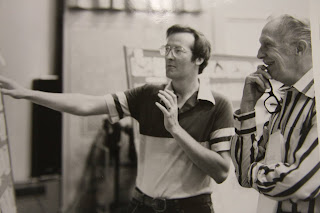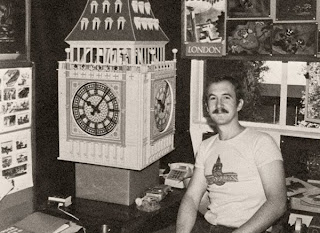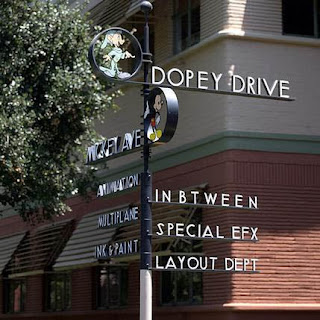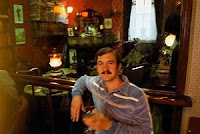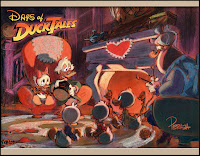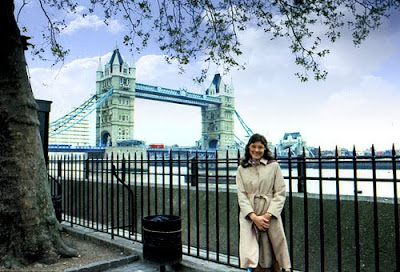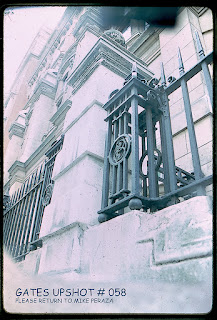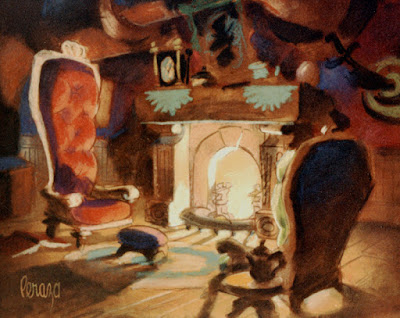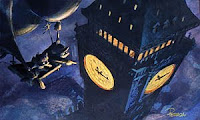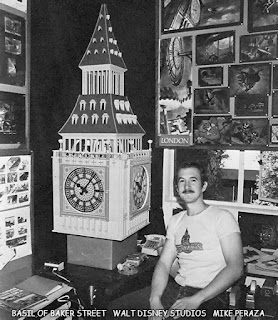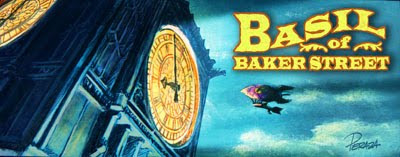
"
The Black Cauldron" was to be a return of greatness for Disney Feature animation. There was a lot of fresh new talent alongside veteran Disney artists to bring it to the screen. Somewhere along the way as it slowly creeped through production, I just found it difficult to get excited about the direction Cauldron was taking. I wasn't as thrilled about it as I had been when I first saw Mel Shaw's dramatic pastels for the film. He had captured a tale of sweeping adventure and fantasy in brilliant colors. For me, that excitement had been watered down. I wasn't alone. There were others too who wanted to work on something else. That something else became, "
Basil of Baker Street."
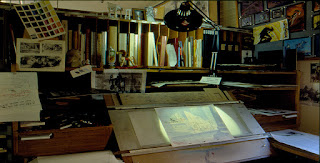 |
One of two desks I used simultaneously during Basil.
Here I'm working out the staging outside the toyshop |
Mel Shaw had also been sketching pastels for a new film with the working title, "
Basil of Baker Street." Among the early participants were Directors, Burny Mattinson, John Musker, Ron Clements, Dave Michener, animator/character designer Ed Gombert and storyman Vance Gerry and Don Griffith and I doing concepts. Don Griffith provided some excellent visuals for the Dancehall/Waterfront dive area and I likewise did my best to keep up with my mentor doing the flat, lab, and toyshop. The group was dynamic to say the least. Burny could make these gorgeous charcoal story sketches with lots of appeal and he was an upbeat person to be around. I knew John from Cal Arts days and he was a mark above most even back then with a satirically sharp edge on his drawings. Ron had heart, plenty of it and really studied film techniques as in the 3 C's. Dave was a true veteran of Disney, working close with Milt Kahl for years, and his draughtsmanship was impeccable. Ed was a keen talent in many areas whether designing a character or executing a story sketch and I enjoyed his offbeat humor. Vance was just an easy going mellow soul who was fun to talk to and he could knock out beautiful expressive story panels that nailed each moment in the story arc.
The story was based on a series of children's books by Eve Titus where a mouse fashioned after London's greatest detective lives just beneath that famous 221B Baker street address. His archenemy is Professor Ratigan, a nod to Professor Moriarty from the Sherlock Holmes world. At one point the little girl, Olivia, was older and a possible love interest for Basil but it was deicided a small girl searching for her father would gain more feeling between our leads in the story dynamic. Basil also plays the violin quite well in our movie whereas in the books he's horrible with the instrument. Basil was named in honor of Basil Rathbone who played the detective role famously for MGM and Universal studios for many years.
Ken Anderson had done a marvelous workbook for "
Ben and Me", and I was using copies of those as a guide to workbooking for Basil. The productions hadn't been using workbooks in their planning for many years. I'm guessing because the older crew with icons like Don Griffith and Mac Stewart and others had gained so much experience that they could just go from story sketch to layout with a minimum of problems. Well I wasn't as experienced or comfortable doing that so I liked relying on workbooks to aid in the staging process. I did all my thumbnails and even full size layouts in charcoal, sometimes using a carbon pencil for tight detail line work. I also made what I called "Color Ribbons" in small thumbnails to show the progression of color which is so important to setting mood and having an emotional impact. I got that idea from Fantasia, where they had these great little charts showing the abstract color in a sequence and how it would flow through the story. These were then set using workable fixative.
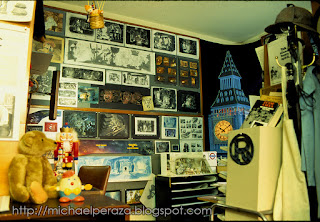 |
| A rather messy corner of my room at the old Disney Studio |
In those days we were still in the original animation building where they had done everything from Pinocchio onward and thank goodness the windows could be opened. This way I wasn't asphyxiating myself or my crewmates although that fixative odor could really linger. John Musker would routinely enter my room and ham up his gagging when he heard me spraying. HA, HA, HA, what a card, sheesh, hey I had to do something to make that stuff quit rubbing off! The sequences I was mainly responsible for designing were the opening title, Basil's flat (Basil's introduction), the Toyshop and the climactic fight (chase across sky onto and into Big Ben). Gil Dicicco who was also an Art Director on Basil for a while and did Ratigan's Lair along with the final waterfront look with marvelous watercolor studies. He introduced me to using FW Inks which gave you these brilliant colors and had an excellent permanence in light. Sadly the FW formula changed from carbon to acrylic about 10 years ago and the colors are milky these days. Brian Mcentee did Mr. Sherlock Holmes' flat upstairs and exterior streets of London with wonderful pastels. He did a series of those pastels set in the early morning just after my toyshop chase as Basil, Olivia and Dawson trot homeward on the back of bloodhound Toby while the lamplighter douses the gaslights one by one. Henry Mancini set music to them based on Big Ben's bell chimes and the total effect which brought tears to your eyes. It had the potential of, "Feed the Birds" from "Mary Poppins", to my mind. Unfortunately it was cut. It's a shame because the pacing gave us a heartfelt piece of emotion and a breather between two chase sequences and I really thought that helped the overall pacing.
